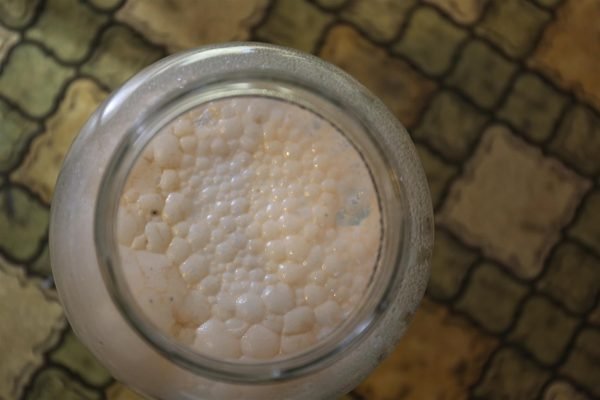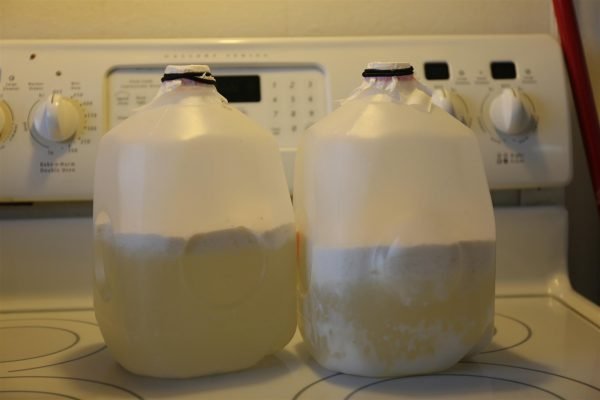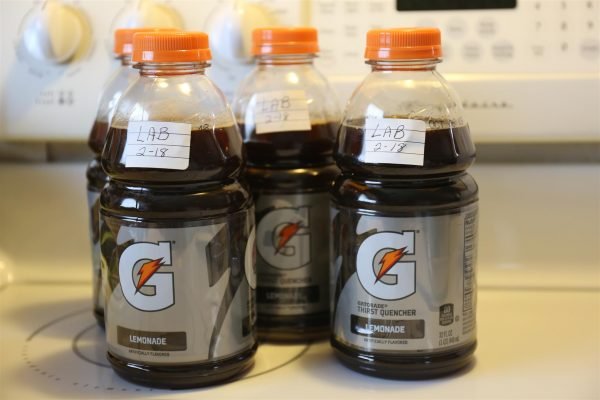Any complex carbohydrate can be used to start this mixture, such as potatoes, bread and most grains. In this recipe white rice is used. Put about one cup of white rice in a bowl or quart jar. Cover rice with the purest water you have and swish it around to rinse it off. Dump the rinse water into another jar, rinsing a second time if necessary. The goal is to get about 3 cups of rinse liquid out of this. (Use the rinsed rice for food or another project).

Cover the rinse water filled jar with a cotton cloth or coffee filter, and slip the jar ring over that or use a rubber band, or twine or anything that will secure the paper or cloth snugly to the jar, while still allowing the solution to breath.

Place prepared jar into a dark, warm area. Depending upon the conditions, it will take anywhere from 2 -7 days to fully ferment. A bottom layer of sediment will form, a liquid middle area, and a bubbly top layer. It is the middle layer we are after. Once the top is bubbling, and still has a pleasant sweet and sour odor, a turkey baster can be used to remove the middle layer. I use a larger jar, and just carefully dip a ladle in, first skimming off the top layer (that goes in the compost), and then I am careful to remove the middle layer without disturbing the bottom sediment.

Once the middle part is separate from the rest, add the fermented rice rinsings to the milk. The ratio is approx. one part fermented rinsing water to ten parts of milk. So for each ten cups of milk, use one cup of the rinse water. I split a gallon of milk between two empty gallons, two quarts in each one, then I add almost a cup of the rinse water to each container and swish gently to combine. Any cow milk can be used, even powdered. I suspect it also works with other animal milks but I have not experimented with this. Now that the fermented rice water and milk mixture is combined, cover again with a piece of cloth or paper, and put back in the warm dark area. It should only take two or three days to curdle, but it might take a day or two longer depending upon such things as temperature. Ferment the milk until it has separated into curds and whey. If you know how to make a farmers cheese, use the curd part to make a nice cheese. It is the liquid in this mixture that will be used for the LAB. Pour the mixture through a cloth lined sieve to extract the liquid. Now you have your Lactobacillus Serum. You can store it in bottles or jars, refrigerated, for up to a year. If you wish to stabilize it indefinitely, mix one part of the LAB Serum with one part of molasses. Stabilized LAB Serum does not need to be refrigerated.
*This product is the base for many plant nutritional additives. It breaks up nutrients into a form that vegetation can use. It counteracts rotting, takes care of bad smells, neutralizes urine, helps mycellium to grow, is good for feeding plant leaves and roots, animal husbandry, solid waste management, sewage and waste water treatments, polluted water, sanitation, walls, floors, kitchen counters, dilute 1 – 10 for cleaning, 1 – 1000 for plants and such.
Just finished my first serum tonight. Thanks for sharing here.
Downvoting a post can decrease pending rewards and make it less visible. Common reasons:
Submit